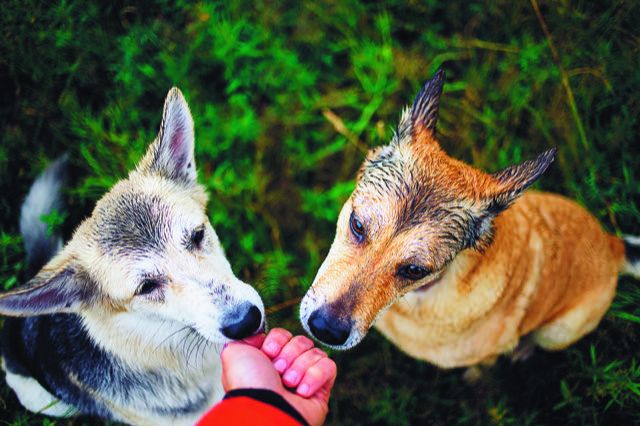Imagine if you reached out to shake someone’s hand and they grabbed you by the shoulders and kissed you on the lips. Dogs go through that level of emotional discomfort all the time because people mistakenly think they’re always ready for intense socializing. They’re not — not all of them, anyway.
It’s easy to get it wrong. Let’s say a dog comes over to get a whiff of you. You might think that’s a sign of social intimacy and bend right down to her face and pat her on the head. But sniffing you is just a way of “looking at” you, the way you might look at someone as you pass them on the street. Getting face-to-face and petting a dog on the head (which they see as aggressive) is much too forward a response.
Many dogs put up with it because they study our ways and learn that we don’t mean any harm. But wouldn’t it be better if we also learned their ways so we could be sure we’re treating them respectfully? People do it for cats all the time — take things gingerly in order not to upset their equilibrium. It’s time we extend that same courtesy to dogs. Here are three communication signals dogs give that are commonly misinterpreted.
1. Scratching, sneezing. Sure, scratching could mean “itchy,” and sneezing could mean “sinusy.” But they can also be displacement behaviors when a dog is experiencing inner conflict. The conflict is that the dog is stuck doing one thing when she wants to be doing another. For instance, if you walk over to a dog and she immediately drops down and starts scratching, it’s probably to displace the behavior she really wants to be engaging in — getting away from you. A dog may start yawning for the same reason — as a valve to let off tension from something that is making her feel uncomfortable. Ditto: sneezing.
2.
Closed-fist cha-cha. You make a fist to let a dog sniff you before you go to pet her. She backs up, but you feel you’ve done your job of getting her used to you, so you start petting, anyway. She then backs up some more, which makes you try even harder to pet her because you’ve done what you’re supposed to in order to “gain her trust.” No, you haven’t. She’s uncomfortable, or even scared. That’s because a dog may very well take a fist in front of her nose as an aggressive signal.
If a dog is backing up from you or moving her head away from your hand, she does not want you to touch her. Not every dog wants to be petted by every person who feels like interacting with her.
3.
Tail wagging. It’s not a sign of happiness. It’s a sign of arousal that is sometimes about happiness, but not always. That confusion leads to people taking their dog to the Tufts Animal Behavior Clinic. A client will say, “A kid bent down to pet my dog when his tail was wagging, so I thought it was okay, but the dog snapped at the kid. I
don’t get it.” In that case, the tail wagging was a prelude to aggression, not a pleasant interaction.
Think of it the way you would the volume of someone’s voice. You can’t tell just by how loud it is whether the person is upset. You have to tend to the tone of the words. Perhaps the person is cheering on their team — or screaming out the window to someone who has just cut them off in their car.
Look for the dog’s “tone” through her other body signs while her tail is going. Is her body carriage stiff, rigid? Are her ears pinned back? Does she have a fixed stare, or are her eyes blinking rapidly? None of these are good signs. A rigid stance means the dog is ready to fight, while pinned-back ears and rapid blinking indicate anxiety, and a fixed stare signals either aggression or fear that can lead to aggression. And if the mouth is pulled back tight with the teeth showing, “you listen to the teeth, not the tail,” says Tufts animal behaviorist Stephanie Borns-Weil, DVM.
On the other hand, if the dog’s body is calm and the eyes are relaxed and happy, a wagging tail is a good sign. Ditto for a relaxed mouth, either open or closed, and loose skin over the face.





